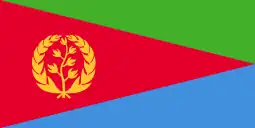Great Mosque of Asmara
The Great Mosque of Asmara; alternately known as Al Kulafah Al Rashidan, Al Kulafah Al Rashidin, Al Kuaka Al Rashidin or Al Khulafa Al Rashiudin (Arabic: جَامِع ٱلْخُلَفَاء ٱلرَّاشِدِيْن, romanized: Jāmiʿ al-Khulafāʾ ar-Rāshidīn, "Mosque of the Rightly-Guided Caliphs"); is a mosque located in the center of Asmara, the capital city of Eritrea.[1] It is considered to be one of the three prominent edifices of the city, along with Church of Our Lady of the Rosary and Enda Mariam Coptic Cathedral.[2] Designed by Guido Ferrazza, it was built in 1938 on the initiative of Benito Mussolini, to impress the Muslim population, who make up about 50% of the locality.[3][4] The Arabic phrase al-Khulafā’ ar-Rāshidīn can mean "followers of the right path".[4]
| Great Mosque of Asmara | |
|---|---|
Jāmiʿ al-Khulafāʾ ar-Rāshidīn (جَامِع ٱلْخُلَفَاء ٱلرَّاشِدِيْن) | |
.jpg.webp) | |
| Religion | |
| Affiliation | Islam |
| Location | |
| Location | Asmara, Central, Eritrea |
 Shown within Eritrea  Great Mosque of Asmara (Africa) | |
| Geographic coordinates | 15°20′20″N 38°56′30″E |
| Architecture | |
| Type | Mosque |
History
Completed in 1936, this huge complex is a combination of rational, classical and Islamic styles. However, the interior of the mosque is open to Muslims only, but people of all faiths are allowed to enter through the main entrance.[5]
Features
The mosque was designed by Guido Ferrazza, in a blend of the architectural styles of Rationalist, Classical, and Islamic.[6][7] The minaret at its end, fluted and of Roman design, is visible from all parts of the city. It has two platforms and two balconies of the Italian rococo or late baroque style. Below the minaret, the mosque's fascia has a neoclassical loggia (exterior galleries), which is split in three parts. The building's double columns are made from Dekemhare travertine and are fitted with capitals made of Carrara marble.[8] Other features include Islamic domes and arches. The mosque's miḥrāb (Arabic: مِـحْـرَاب, a niche which faces the direction of Mecca) is made of Carrara marble.[9] Additional marble from the same quarry is used in other areas of this mosque.[6] The front open yard of the mosque is covered with black stone slabs set in geometrical design.[2]
The Eritrean mosque serves as a symbol of national unity for the country's 42% Sunni Muslims, who, from different parts of the country, regularly come to the mosque for prayers, and the participation is significant during the month of Ramadan and the Friday prayers.[10]
References
- Fuller 2007, p. 91.
- "Religious sites of Asmara (1)". asmera.nl. Retrieved 26 April 2015.
- Griswold 2011, p. 189.
- Starbird & Bahrenburg 2004, p. 36.
- "Great Mosque | Asmara, Eritrea Attractions". Lonely Planet. Retrieved 2022-04-17.
- House 2004, p. 244.
- Connell & Killion2010, p. 78.
- Cantalupo 2012, p. 145.
- Carillet, Butler & Starnes 2009, p. 322.
- "Religious Faith And Persecution In Eritrea". WorldAtlas. 2017-04-25. Retrieved 2022-04-17.
Bibliography
- Cantalupo, Charles (1 January 2012). Joining Africa: From Anthills to Asmara. MSU Press. ISBN 978-1-60917-313-5.
- Carillet, Jean-Bernard; Butler, Stuart; Starnes, Dean (2009). Ethiopia & Eritrea. Lonely Planet. ISBN 978-1-74104-814-8.
- Connell, Dan; Killion, Tom (14 October 2010). Historical Dictionary of Eritrea. Scarecrow Press. ISBN 978-0-8108-7505-0.
- Fuller, Mia (24 January 2007). Moderns Abroad: Architecture, Cities and Italian Imperialism. Routledge. p. 51. ISBN 978-1-134-64830-6.
- Griswold, Eliza (3 February 2011). The Tenth Parallel: Dispatches from the Faultline Between Christianity and Islam. Penguin Books Limited. ISBN 978-1-84614-422-6.
- House, Media (1 December 2004). Columbus World Travel Guide, 2004–2005. Highbury Columbus Travel Pub. ISBN 978-1-902221-84-7.
- Starbird, Caroline; Bahrenburg, Amy (1 January 2004). Step Into Africa. University of Denver, CTIR. ISBN 978-0-943804-87-3.

